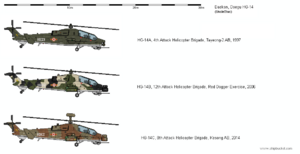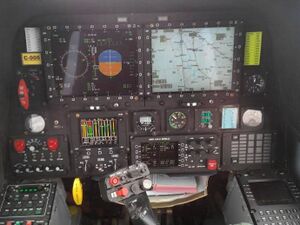Daegu HG-14
| Daegu HG-14 | |
|---|---|
 Main HG-14 variants | |
| General information | |
| Type | Attack helicopter |
| Manufacturer | Daegu Aircraft Company |
| Status | In service |
| History | |
| Manufactured | 1993 |
| Introduction date | 9 April 1994 |
The Daegu HG-14 (헬리콥터, 공격 14; Helicopter, Attack (No.) 14) is a Daekanese twin-engine, twin tandem cockpit attack helicopter. Designed and produced by the state-owned Daegu Aircraft Company, the HG-14 makes up the backbone of the Daekanese People's Army Ground Force's attack helicopter fleet. The HG-14 is an all weather, day-night attack helicopter optimised for the anti-tank role, and carries a nose mounted sensor suite for target detection and acquisition. The helicopter is armed with a chin-mounted GW-16/23 23mm chain gun, and features pylons under each stub wing that are able to mount a variety of ordnance.
Origins and development
Daekan became interested in attack helicopters early on in their developement. The country's number one defensive priority was a large-scale land war on the long border with Esgonia, and a dedicated attack helicopter for close air support (especially in the anti-armour role) was deemed necessary. Daekan first secured the sale of 40 Mi-24Ds from Vanquaria in 1978, with the aircraft delivered the same year. While overall liking the aircraft and its capabilities, the Daekanese military leadership considered it cumbersome and overly large, while its secondary transport capability was seen as next to useless was seldom used save for special forces insertions. Plans were drafted to design and produce a domestic attack helicopter, but the disastrous 7th Five-Year Plan and the Daekanese economic crisis put a halt to those plans. The military, however, still demanded an attack helicopter. In 1979, domestic production rights for the Mi-24 were secured, with first factory being opened in 1980.
The Mi-24 remained the DPA's main attack helicopter throughout the 1980s, with production picking up in the latter half of the decade as Maeng Song-Hun's reforms revitalised the economy. The concept of a domestically designed attack helicopter was again brought up. The technology and information transfer for the GK-Valaran Agusta A129 Mangusta in the late 80s had many suggesting a copy of that design, but the DPA leadership decided against it for both political and design reasons. The plans were used to design the Daegu HU-10 utility helicopter instead.
In 1991, the government officially started the competition for a new attack helicopter design. The Daegu-based Daegu Aircraft Company's design, a four-blade, tandem seat design with engines based on the A129's Rolls-Royce Gem 2-1004D, garnered particular interest. After going through several reiterations, the prototype made its maiden flight in 15 September 1992. The second prototype crashed due to engine failure later that year, and the engines were reworked and improved. The third prototype performed a demonstration for DPA officials in 1993. The type was officially adopted and given its official DPA designation "HG-14" later that year. The first batch of helicopters was delivered to the 12th Attack Helicopter Brigade in 1994.
Design
Airframe and engines
The HG-14 has a four-blade main and tail rotor powered by two Daegu ET-series engines featuring high-mounted exhausts on either side of the fuselage. The Daegu ET-series was allegedly developed with Rolls-Royce Gem 2-1004D technology transfered from the Kesong Helicopter Plant, a claim that the Daegu Aircraft Company disputes. Several engine models have been used on the different variants, with varrying power. The first batch HG-14As had the infamously underpowered 1000 shp (745 kW) ET-200A engines. These were later replaced by the much more powerful 1350 shp (1006 kW) ET-300A engines, with the improved ET-300B model equipping the HG-14B. The ET-400As, that are featured on the most recent HG-14C variant, have an output of 1,600 shp (1,193 kW) each.
Two two-man crew sits in a tandem cockpit, with the pilot behind and above the gunner. Each crewman can both fly and control the weapons system independently, guaranteeing that the helicopter will remain combat effective even if one of the crew is hit. The crew compartment is armoured and rated to be able to withstand hits from up to 14.5 mm caliber bullets, and the armour plating between the the pilot and the gunner can withstand 23mm rounds. The HG-14 also features a self-sealing fuel system. The HG-14 has a non-retractable, energy-absorbing tricycle tail-wheel type landing gear, which, combined with the energy-absorbing seats, make crashlandings more survivable for the crew.
Avionics and Armaments
Both crewmembers are equipped with helmet mounted displays (HUD) and night vision googles (NVGs). In the HG-14C variant, the upgraded HUD allows the crew to slave the 23mm chain gun to their HUDs, making it follow their head movement and aim where they are looking at. The HG-14 also features the JGS-1 battle management system (JGS-2 in the HG-14C), integrated communcations and data links and a high-authority digital automatic flight control system. The intergrated navigation suite includes GPS, radar altimeter (fully interchangable with a laser altimeter) and air speed sensors, as well as doppler navigational radar. The cockpit layout for each crew member included three LCD multi-function displays in the HG-14A and HG-14B variants, while these are replaced with two larger ones in the HG-14C.
The electronic warfare (EW) suit, officially designated Jae-1, includes radar-warning receiver (RWR), laser warning receivers (LWR), eletronic counter-measures (ECM) and electronic support measures (ESM) and an infared jammer. The system can automatically identify threats and attempt to jam or launch countermeasures accordingly. The upgraded Jae-2 system, mostly a software upgrade, was introduced in 2013 and is featured on the HG-14C.
The HG-14C introduced the "Dal-1" millimeter-wave (MMW) fire-control radar housed in a dome above the main rotor. The Dal-1 allows the HG-14C to track more than 100 targets and engage 14 of them simultaneously. Its elevated position allows the helicopter to hide behind obstacles in the terrain, such as trees or hills, and still be able to identify, track, and engage targets. The system can also broadcast targetting information with other aircraft or ground units, enabling them to fire on the HG-14Cs target without necessarily having spotted it themselves. This capability has made the HG-14C a valuable recon asset.
Operational history
The DPAGF Aviation Command currently operates about 150 HG-14s, most being of the HG-14B variant. Only about 40 HG-14Cs have been delivered due to a 3-year pause in production, but since 2017 production has been continued. It is expected that 250 HG-14s in total will be produced for Daekan. Most of the DPA HG-14s are deployed with units of the Western Theatre Command on the Esgonian border. Daekanese HG-14s have so far not seen any active combat.
Operators
 Daekan: The Daekanese People's Army Ground Force Aviation Command operates 150 HG-14s of all variants. 100 more are expected to be produred.
Daekan: The Daekanese People's Army Ground Force Aviation Command operates 150 HG-14s of all variants. 100 more are expected to be produred. Pakiranistan:
Pakiranistan:
Variants
- HW-010-1: Prototype variant. It featured the Daegu ET-100A turoshaft engines and large, three-hardpoint wings.
- HW-010-2: Second prototype variant. Smaller, two hardpoint wings and improved avionics.
- HW-010-3: Third prototype variant. Improved ET-300A turboshaft engines and altered cockpit design.
- HG-14A: First production variant. Characterised by the ball-shaped EO gimbal on the nose.
- HG-14B: Upgraded variant introduced in 2005. Features an upgraded EO and avionics suite, as well as improved armour panneling.
- HG-14C: Further modernisation introduced in 2014. Improved ECM, infared jammer and radar warning receiver. Most notably, it mounts the LS/H-12 millimeter-wave fire-control radar housed in a dome above the rotor. It also features the upgraded ET-400A engines.
- HG-14H: Naval variant with nose mounted radar among other changes. Prototype only.
Specifications (HG-14B)
General characteristics
- Crew: 2 (pilot and weapon systems officer)
- Length: 17.51 m (57 ft 5 in) fuselage
- Height: 4.2 m (13 ft 9 in)
- Empty weight: 7,300 kg (16,094 lb)
- Gross weight: 9,500 kg (20,944 lb)
- Max takeoff weight: 10,670 kg (23,523 lb)
- Powerplant: 2 × ET-300B turboshaft engines, 1,010 kW (1,350 shp) each
Performance
- Maximum speed: 280 km/h (174 mph; 151 kn)
- Cruise speed: 240 km/h (149 mph; 130 kn)
- Range: 800 km (497 mi; 432 nmi)
- Ferry range: 1,300 km (808 mi; 702 nmi) 4x drop tanks with 5% reserve
- Service ceiling: 5,700 m (18,700 ft)
- Rate of climb: 13.6 m/s (2,680 ft/min) max at sea level
Armament
- Guns: x1 GW-16/23 23mm (0.906 in) chain gun with 300 rounds
- Hardpoints: 4
- Rockets: 57 mm (2.244 in), 80 mm (3.150 in) 122 mm (4.803 in) unguided rocket pods
- Missiles: Typically GJ-7 and GJ-10 series ATGMs, DG-6 AGMs, HJ-5 and BL-14 AAMs
- Bombs: Up to 500 kg bombs
